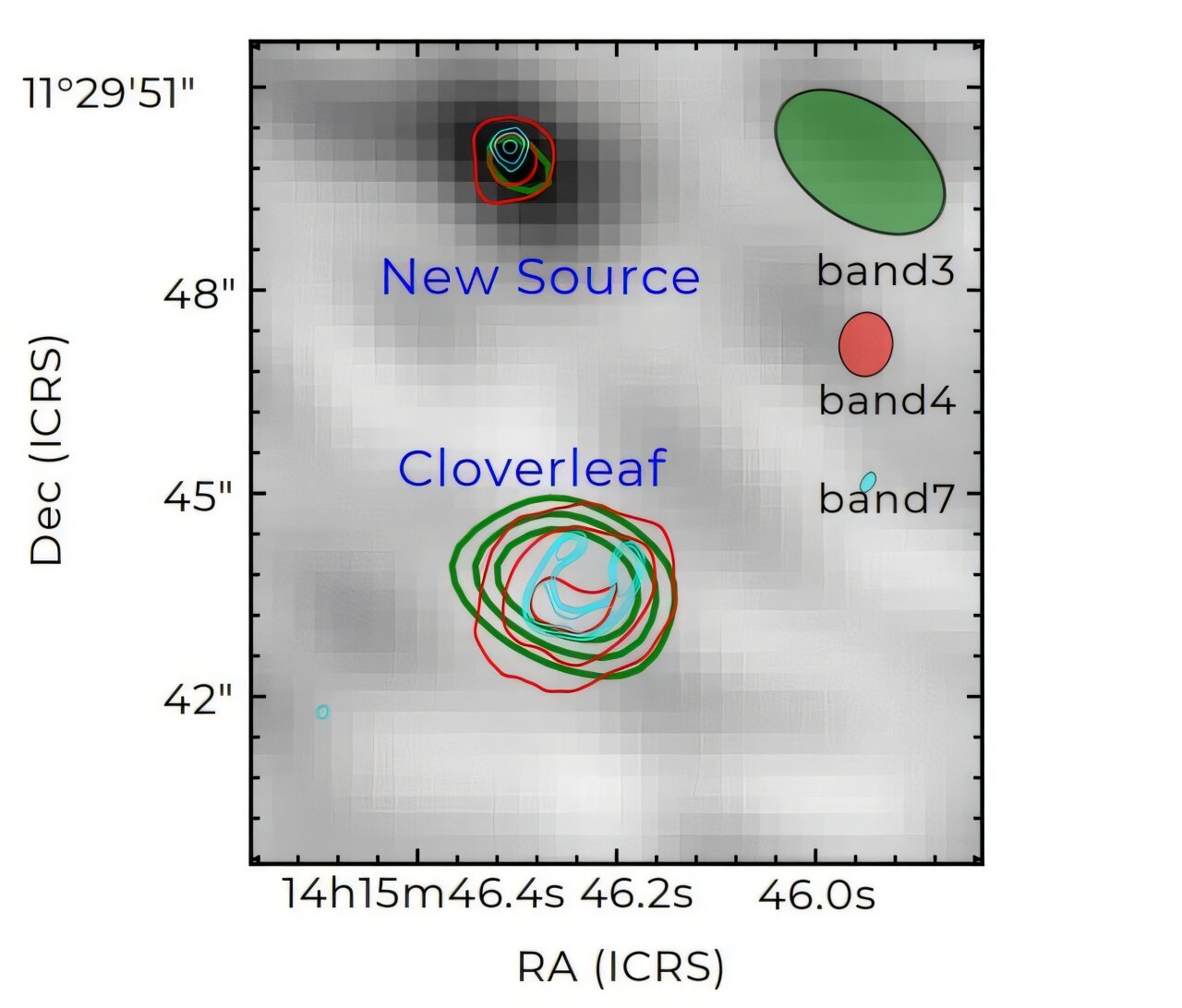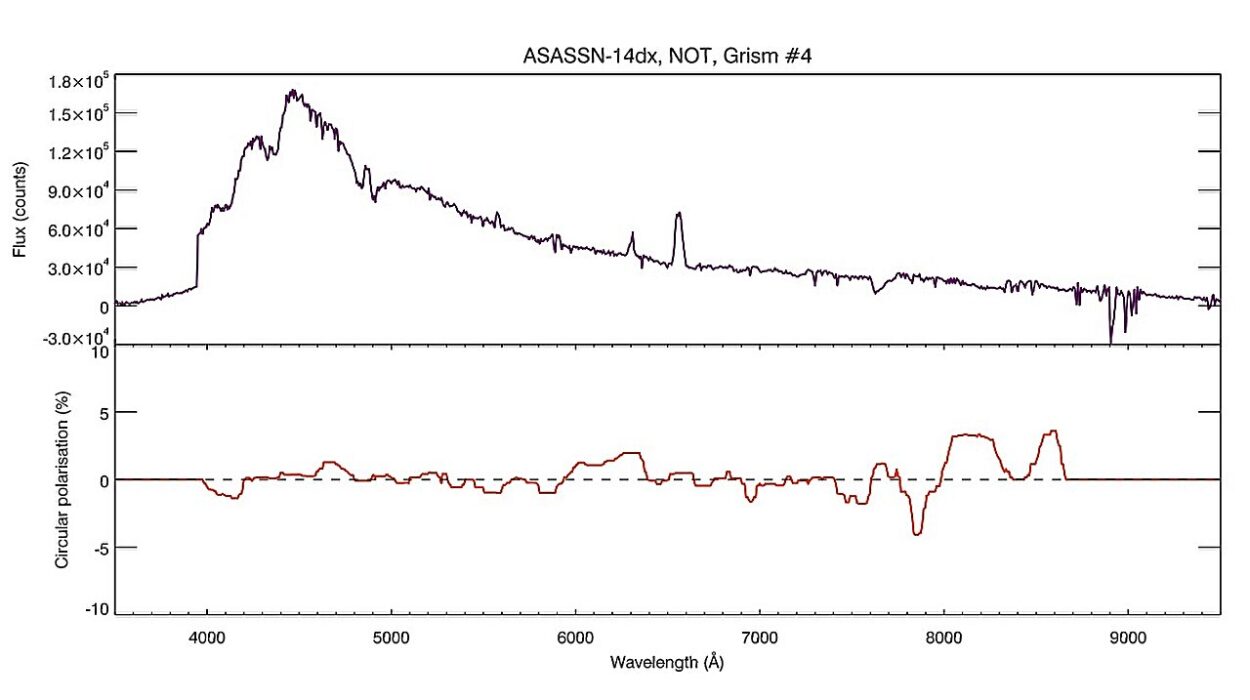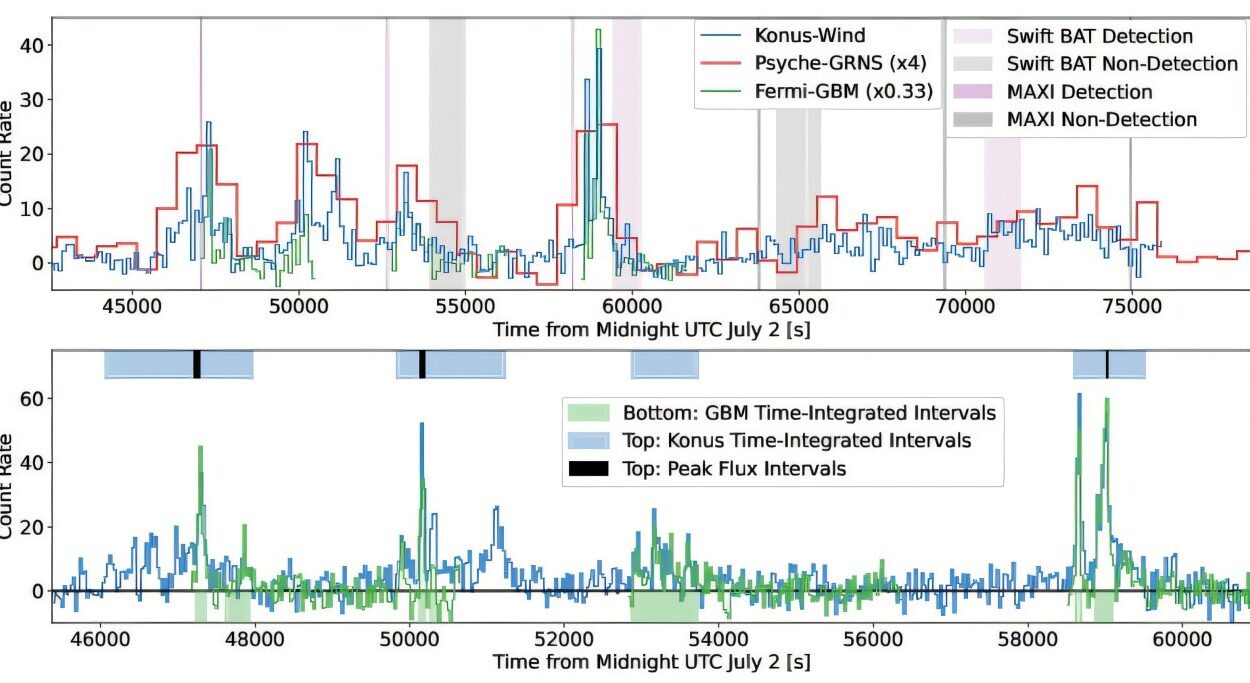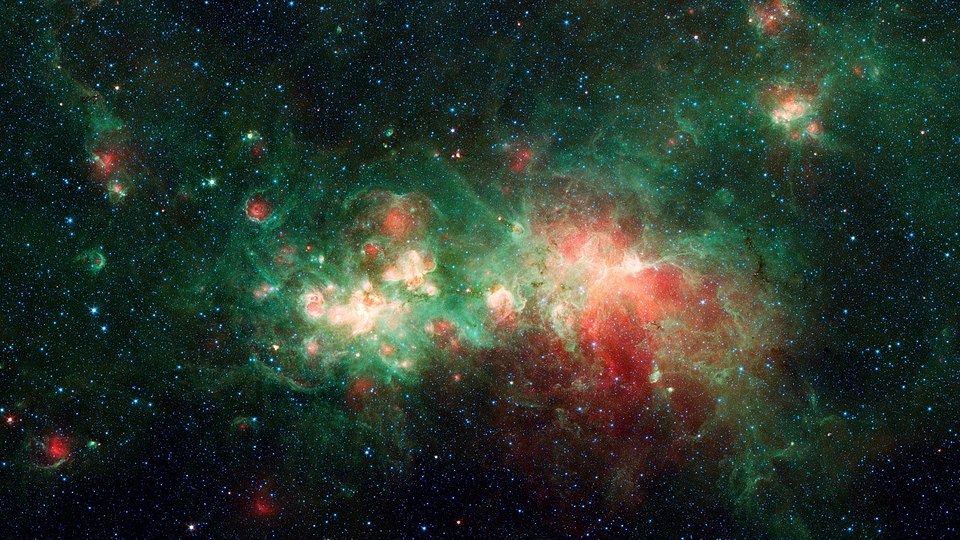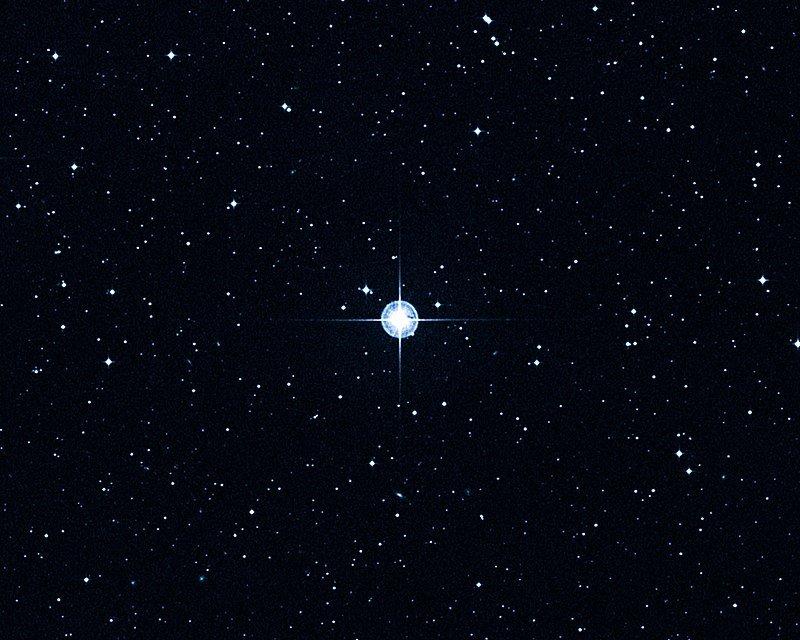Sometimes, in science, discovery happens not by intention but by sheer cosmic coincidence. Such was the case when an international team of astronomers, using the powerful Atacama Large Millimeter/submillimeter Array (ALMA) in Chile, peered into the depths of space to study a well-known quasar called the Cloverleaf. What they found instead was something entirely unexpected — a new, ultra-luminous infrared galaxy hidden behind it, blazing with the energy of trillions of suns, yet invisible to the naked eye.
Reported on September 30 in the Monthly Notices of the Royal Astronomical Society, this serendipitous discovery opens a new window into the early universe, revealing a galaxy that could hold secrets about how stars — and perhaps even galaxies like our own — are born.
The Cloverleaf Quasar
The Cloverleaf, officially named H1413+117, is not just another distant light in the sky. It’s a quasar — the brilliant core of a galaxy powered by a supermassive black hole feeding on infalling gas. Located about 11 billion light-years away (at a redshift of 2.56), the Cloverleaf quasar is one of the most studied celestial objects of its kind. Its nickname comes from its appearance: gravitational lensing by a massive galaxy between us and the quasar splits its light into four distinct images that resemble the shape of a four-leaf clover.
Gravitational lensing, predicted by Einstein’s theory of general relativity, acts like a cosmic magnifying glass. It bends and amplifies the light from background objects, allowing astronomers to detect galaxies that would otherwise be too faint or distant to see. In this case, that same lensing effect that made the Cloverleaf famous also revealed something entirely new — an unseen galaxy hiding in the background.
An Invisible Giant Emerges
During their observations with ALMA, astronomer Natsuki H. Hayatsu and colleagues noticed something unusual. Just six arcseconds away from the Cloverleaf’s position — a minuscule distance on the sky — they detected strong millimeter-wave emissions, the telltale signature of cold dust and gas. What they found turned out to be a new ultra-luminous infrared galaxy (ULIRG), one of the most energetic and star-forming systems in the cosmos.
This newfound galaxy, at a redshift of approximately 3.39, is so distant that its light has traveled for nearly 12 billion years to reach us. Its energy output is astonishing — over 2.8 trillion times brighter than the Sun in infrared light. Yet, paradoxically, it is completely invisible in optical wavelengths, shrouded in thick clouds of interstellar dust that absorb visible light and re-emit it in the infrared.
Astronomers call such galaxies optically dark, and they are notoriously difficult to find. These dusty galaxies are often overlooked in traditional optical and ultraviolet surveys, but they are believed to be key players in the universe’s early history of star formation.
The Power of an Ultra-Luminous Infrared Galaxy
ULIRGs are among the most extreme environments in the universe. Their infrared luminosities exceed one trillion times that of the Sun, and their star formation rates can reach an astounding 100 to 1,000 solar masses per year. To put that in perspective, the Milky Way forms just one or two solar masses of stars annually.
In this newly discovered galaxy, astronomers estimate a molecular gas mass between 40 and 230 billion solar masses, providing a vast reservoir of material for future stars. At its center lies a supermassive black hole roughly 100 million times the mass of the Sun, devouring gas and dust as it grows.
Its total X-ray luminosity was measured at about 4 × 10³⁹ erg/s, while its total infrared luminosity — the heat glow from its dust — is around 2.8 × 10¹² solar luminosities. These figures place it firmly among the brightest known galaxies in the cosmos.
A Galaxy in Turmoil
Despite its brilliance, this galaxy is far from tranquil. The ALMA data suggests that its molecular gas has not yet settled into a stable disk, a sign of dynamic chaos. The most likely cause? A massive, gas-rich merger between two galaxies.
Such mergers are among the most violent events in the universe. When galaxies collide, tidal forces tear apart their structures, compressing gas clouds and igniting furious bursts of star formation. These “starbursts” can create thousands of new stars every year, transforming a once-quiet galaxy into a cosmic furnace.
In this case, the researchers believe the merger is still in its early stages. The galaxy’s molecular gas is highly turbulent and unorganized — the raw material for an enormous wave of future star formation. In time, this chaotic system will likely stabilize, maturing into a more familiar galactic form.
A Glimpse Into Galactic Evolution
Astronomers think this newfound ULIRG may represent a key stage in galactic evolution — a bridge between dusty, starbursting galaxies and active galactic nuclei (AGN), where central black holes dominate the energy output.
Over cosmic timescales, galaxies like this one may evolve through several dramatic phases. Initially, they exist as dust-obscured starbursts, rich in gas and actively forming stars. As the central black hole grows, it begins to heat and expel surrounding material, creating a hot dust-obscured galaxy (or “hot DOG”). Eventually, as the dust clears, the galaxy becomes a quasar, with the black hole shining brightly at its core. Finally, after exhausting its fuel, it settles into an elliptical galaxy — massive, old, and relatively quiescent.
This evolutionary journey, from dusty chaos to cosmic calm, helps astronomers understand how galaxies like our own Milky Way came to be. The newly discovered galaxy may represent a progenitor stage — a snapshot of this transformation frozen in time, 12 billion years ago.
The Mystery of the Optically Dark Galaxies
The discovery also sheds light on a mysterious population of galaxies that have long eluded astronomers — those that shine brightly in submillimeter and infrared wavelengths but are nearly invisible in optical light. These “optically dark” galaxies may account for a significant fraction of star formation in the early universe, hidden behind veils of dust that traditional telescopes cannot penetrate.
Detecting them requires specialized instruments like ALMA, which can observe the cold dust and molecular gas that betray their presence. Such galaxies may hold the key to solving one of astronomy’s biggest puzzles: how the universe built its first massive galaxies so quickly after the Big Bang.
What the Discovery Means for Astronomy
The significance of this discovery goes far beyond a single galaxy. It demonstrates how powerful tools like ALMA can reveal previously unseen corners of the cosmos, uncovering galaxies that could rewrite our understanding of early star formation.
By studying this newly found ULIRG, astronomers hope to learn how gas behaves in such extreme environments, how starbursts ignite and fade, and how supermassive black holes grow in tandem with their host galaxies.
Future observations — particularly those focused on the dense molecular gas — will be crucial for determining the galaxy’s true nature. Is it primarily a star-forming system, or is its brightness already being fueled by an emerging quasar? Only time and deeper data will tell.
A Window Into Cosmic History
Looking at this galaxy is like peering through a time machine. The light we see today left the galaxy billions of years before Earth even existed. In that ancient epoch, galaxies were colliding and merging, stars were being born at furious rates, and black holes were shaping the structure of the young universe.
This discovery gives us a rare glimpse into that turbulent era — a time when the cosmos was still writing its early chapters. Each observation adds another piece to the grand puzzle of how the universe evolved from a primordial fog of hydrogen into the vast, structured beauty we see today.
The Beauty of the Unexpected
Astronomy has always thrived on surprise. The universe often reveals its secrets when we least expect it. The accidental discovery of a hidden, ultra-luminous galaxy behind the Cloverleaf quasar is a reminder that even after centuries of stargazing, the cosmos still holds mysteries beyond imagination.
For the team that made the discovery, what began as a study of one quasar became a revelation about another galaxy entirely — a galaxy so distant and dust-enshrouded that it might have remained invisible forever without the right technology and a touch of cosmic luck.
In the grand tapestry of space, every photon carries a story. Sometimes, when astronomers follow one trail of light, they find another, far more luminous thread — one that connects us to the earliest moments of creation itself.
The Endless Quest for Understanding
The universe is vast beyond comprehension, and every new discovery deepens our sense of wonder. This optically dark, ultra-luminous galaxy — hidden behind a quasar billions of light-years away — is more than a scientific finding. It is a reminder that creation is still unfolding, that the cosmos is alive with activity and mystery, and that humanity’s search for understanding is only beginning.
In the silence between the stars, galaxies are colliding, stars are igniting, and black holes are awakening. And somewhere, among the ancient light that reaches our telescopes, lies a record of everything that has ever been — and everything that will be.
That is the beauty of astronomy: every discovery, accidental or not, brings us closer to knowing our place in the vast and luminous story of the universe.
More information: Natsuki H. Hayatsu et al., Serendipitous Discovery of an Optically-Dark Ultra-Luminous Infrared Galaxy at z = 3.4, Monthly Notices of the Royal Astronomical Society (2025). DOI: 10.1093/mnras/staf1655. On arXiv: DOI: 10.48550/arxiv.2510.00590
